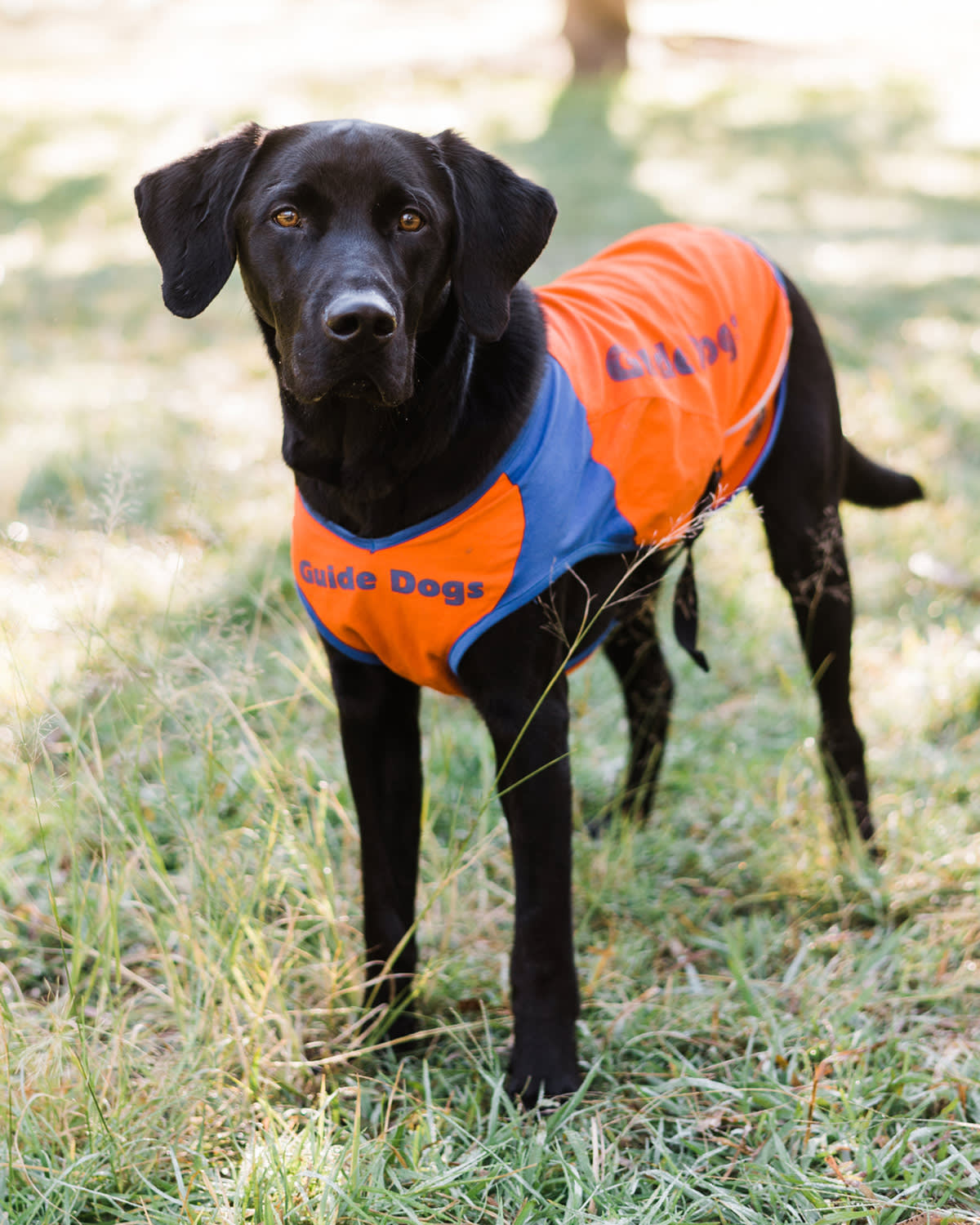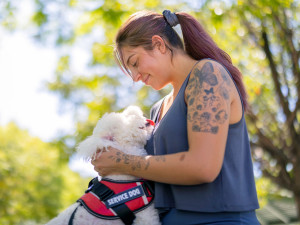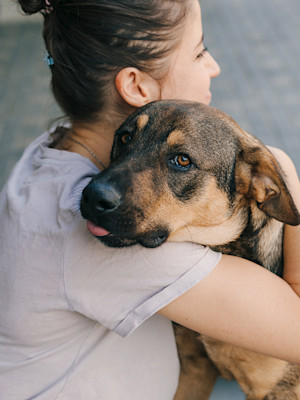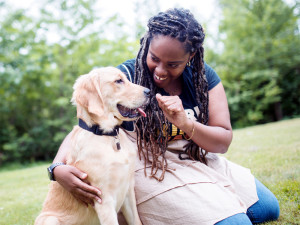Looking to Adopt an Ex-Service Or Assistance Dog? Here’s How
For the dogs who didn’t quite make the cut, but still make perfect pets

Share Article
In this article:
How it works Do assistance and service dogs make good pets? Why assistance or service dogs don’t complete their training Rehoming process Benefits Challenges Where to adopt assistance or service dogs Is rehoming an assistance or service dog right for me? FAQs
Assistance dogs in the UK support individuals who may need additional physical or emotional help by performing tasks that enhance safety and independence, such as retrieving items, providing physical aid, alerting to medical issues and offering psychiatric assistance. In the UK, the term ‘service dogs’ often refers to dogs working within the military or emergency services. While there’s a rigorous selection and training process for these roles, not all dogs complete their training.
Dogs that don’t finish training may not have met specific criteria for their intended roles but can still thrive as companion animals. They often possess gentle temperaments, high obedience levels and a strong affinity for human companionship.
Let’s explore how the rehoming process works in the UK and what makes these dogs special.
How rehoming assistance dogs works
Assistance dogs in the UK are usually purpose-bred by organisations such as Guide Dogs, Dogs for Good or Canine Partners. Their journey starts from birth, with early socialisation in volunteer puppy-raising homes. By around 12–16 months, they begin formal training with professional instructors. This includes learning tasks such as guiding, retrieving items, opening doors, or providing support during medical episodes – depending on the intended role.
Not all dogs complete the programme. Around 30–50 percent are withdrawn from training, but often for reasons that wouldn’t make them unsuitable as pets. Common reasons include:
Mild anxiety or distractibility.
Medical conditions such as allergies or joint issues.
Personality mismatches (eg, too playful, too independent).
Once a decision is made – typically between 6–18 months of age – the dog may be made available for adoption. Some organisations also rehome retired assistance dogs who’ve completed years of service.
Each organisation runs its own application and screening process. You’ll typically need to:
Be over 18
Have a secure home environment (owned or rented with permission)
Commit to not leaving the dog alone for long periods
Be willing to cover veterinary and potential training costs
These dogs are usually well-mannered, socialised and trained in basic obedience. Even if they didn’t meet the criteria for assistance work, they often make exceptional pets for the right home.
How rehoming service dogs works
Service dogs in the UK are typically trained for high-focus roles within the police, military, prison service, or fire and rescue. Depending on their speciality, they may be trained for scent detection (drugs, explosives or cadavers), patrol and protection, or search-and-rescue work. Their training is intensive and begins early in life, with dogs selected for confidence, drive and responsiveness.
Some dogs don’t complete their training, commonly due to:
Excess energy or lack of focus.
Medical issues that limit working ability.
A personality more suited to pet life than operational roles.
Others are retired after years of service. These dogs may still be active, alert and intelligent, but need a slower pace of life in a family home after a hard-working career. They often require structure, mental stimulation and may take time to adjust to civilian life. But in the right environment, they can become deeply loyal, rewarding companions.
Do assistance and service dogs make good pets?
The start of an assistance dog’s life will have been focused on forming strong bonds with humans – so they can make the best of companions. However, beyond their companionship, it’s essential to understand why the dog didn’t complete their assistance dog training. This could be due to health or behavioural issues, so it’s important to ensure you’re equipped to meet the specific needs of the individual dog.
Similarly to assistance dogs, service dogs will have received a great foundation of training. However, they may be used to working in a more high energy role – so might require more mental enrichment and/or physical exercise to fully meet their needs.
Reasons why assistance or service dogs don’t complete their training
Behaviour issues
While working dogs are chosen for their temperament, each dog is of course an individual and may face certain training or behavioural challenges. These can include anxiety, reactivity, poor recall or difficulty with specific tasks such as scent detection.
Health and physical limitations
Health issues can hinder a dog’s future career opportunities. They may have mobility issues, skin allergies, epilepsy or eye conditions, for example. These physical challenges could be easily managed in a pet dog home but not in a working role.
Mismatched temperament
Calm, confident and adaptable dogs make ideal assistance or service animals. Some may not suit the role due to high energy or difficulty handling varied environments.
Rehoming process for assistance and service dogs
The rehoming process will vary slightly depending on the organisation you’re looking to adopt from. The average age of a decision being made on an assistance dog’s future is 6–18 months old – at which point they may be available for adoption – although there may also be opportunities to adopt a retired assistance dog.
The rehoming process is very similar for service dogs as it is for assistance dogs. When looking to rehome a service dog, it may help to reach out to the National Foundation for Retired Service Animalsopens in new tab to find an organisation to work with.
Most organisations will require you to meet certain eligibility criteria, such as being over 18 and owning your own home or having written approval from a landlord. They’ll also want you to agree to certain caregiving levels – including not leaving the dog alone for more than four hours a day and being able to commit to ongoing costs of any training or veterinary support.
The standard process will be for you to register your interest for rehoming an assistance dog, go through an assessment process, then wait for the ideal dog to become available and matched with you. Here is a step-by-step guide:
1. Research potential organisations
Look for organisations that rehome assistance dogs in the UK, such as The Guide Dogs for the Blind Association or Canine Partners. Research the breeds of dogs they use for their assistance dog scheme to see if they would be suitable for your lifestyle.
2. File an application
Most organisations will ask you to complete an online form to gather basic information such as your location, home environment and experience with dogs.
3. Go through a screening process
The screening process will vary per organisation, but can consist of an initial informal phone call, home visits and checking of references.
4. Await a match
This step can take time. Dogs are often offered first to those involved in their care before being matched with the most suitable adopter – not on a first-come, first-served basis.
5. Prepare for your new family member
Ensure you have essentials such as food, a bed and toys ready for your new dog. Consult an ethical trainer for early guidance, and ask the extended family to wait until your dog is settled before visiting.
Benefits of adopting a planned assistance or service dog
Not only are you providing the dog a loving home, you’ll also reap the benefits of the training they’ve already received. Your dog will be used to spending time around humans, so will hopefully become a much loved part of your extended family and friendship circles. You’ll also often have support from the original organisation to guide you through any challenges you may experience in the early stages of your adoption.
Challenges of adopting an assistance or service dog who didn’t make the cut
Dogs won’t make it through to graduation as an assistance dog if they have either a medical or behavioural challenge that doesn’t suit them for their intended role. These reasons may have no impact on how you enjoy your lives together, but sometimes the dog will need extra support in the form of on-going medical help or support from an ethical dog trainer. This may involve financial expenses and demand additional time and effort.
Where to adopt assistance or service dogs who’ve not completed their training
Many assistance dog organisations will rehome dogs who didn’t complete their training or retiring assistance dogs.
Look for an organisation that’s a member of Assistance Dogs UK opens in new tab – ensuring that they work to the highest standards of assistance dog training and welfare. Those include organisations such as:
Where to adopt former service dogs
Service dogs work in a wide range of organisations, including the military, fire service and police forces. They might be retiring dogs or those that haven’t completed their full training.
Organisations worth researching include:
Local Police Constabulary such as this one in Northumbriaopens in new tab
Is rehoming an assistance or service dog right for me?
Rehoming a dog who didn’t finish their assistance or service dog training is a lifelong commitment, just like adopting any other dog – whether they’re a puppy or a rescue. Just like any dog, these pups require significant time, financial resources and emotional support. Before bringing a rehomed dog into your life, it’s essential to consider whether you’re prepared for the lifestyle changes that come with being a dog parent.
Final thoughts: rehoming an assistance or service dog
Rehoming an assistance or service dog offers a unique opportunity to welcome a well-socialised, loving companion into your life. While these dogs didn’t quite fit the working role they were intended for, their extensive training and gentle nature often make them ideal family pets.
Any dog adoption is a commitment and it’s important to consider if you’re ready to provide the necessary care, time, and resources to meet the dog’s individual needs. By doing so, you’ll not only gain a loving companion, you’ll give a deserving dog a second chance at a fulfilling life.
Frequently asked questions
How can I apply to adopt a withdrawn assistance dog?
Go to your chosen organisation’s website and fill in their online application. They’ll then contact you to complete the application process.
Can you adopt assistance dogs that didn’t complete their training?
Yes, some organisations will allow you to adopt assistance dogs who haven’t completed their training – or those who have retired and cannot stay in their current home.
What happens to police dogs that don’t finish their training in the UK?
Police dogs that are withdrawn from training are usually rehomed with families or adopted by their handlers.
How do you rehome guide dogs who don’t finish their training?
You can register your interest to rehome a dog that has been withdrawn from training on The Guide Dogs for the Blind Associationopens in new tab website.
Resources
Asher, Lucy, et al. “Application of Survival Analysis and Multistate Modeling to Understand Animal Behavior: Examples from Guide Dogs.opens in new tab” Frontiers in Veterinary Science, vol. 4, Frontiers Media, July 2017.
Brady, Karen, et al. “F actors Associated with Long-Term Success in Working Police Dogs.opens in new tab” Applied Animal Behaviour Science, vol. 207, Oct. 2018, pp. 67–72.
Caron-Lormier, Geoffrey, et al. “Using the Incidence and Impact of Behavioural Conditions in Guide Dogs to Investigate Patterns in Undesirable Behaviour in Dogs.opens in new tab” Scientific Reports, vol. 6, no. 1, Apr. 2016.
Harvey, Naomi D., et al. “An Evidence-Based Decision Assistance Model for Predicting Training Outcome in Juvenile Guide Dogs.opens in new tab” Plos One, edited by Cheryl S. Rosenfeld, vol. 12, no. 6, June 2017, p. e0174261.
“Re-Homing a Retired or Withdrawn Guide Dog | Guide Dogs.opens in new tab” Guide Dogs Site, 2019.

Caroline Wilkinson
Caroline Wilkinson is a Certified Animal Behaviourist. As the Founder of digital pet coaching service Barket Place, Caroline has a passion for improving connections between human and hound, with a focus on relationships and reduction of stress for canines living in a human world.
Related articles
![dog wearing service dog tabard jumps up at girl with brown hair and tattoos]()
How Psychiatric Assistant Dogs Help Their Humans
“A PAD can be life-changing – and even life saving”
![dog and human hugging]()
Here’s How Much It Costs To Adopt a Dog in the UK
Get your calculator out – it’s time to do some maths
![A woman with dark curly hair lifting a box with a plant in a pot balanced on top to another area in the home]()
How to Prepare For an Adoption Home Visit
7 tips for acing your inspection and bringing your new pup home
![kneeling woman with braids training her golden retriever]()
How to Find the Right Trainer, No Matter What Your Dog’s Been Through
With so many dog trainers out there that it can be hard to know who you can actually trust (especially if your dog has trust issues of their own), here’s where to start…




